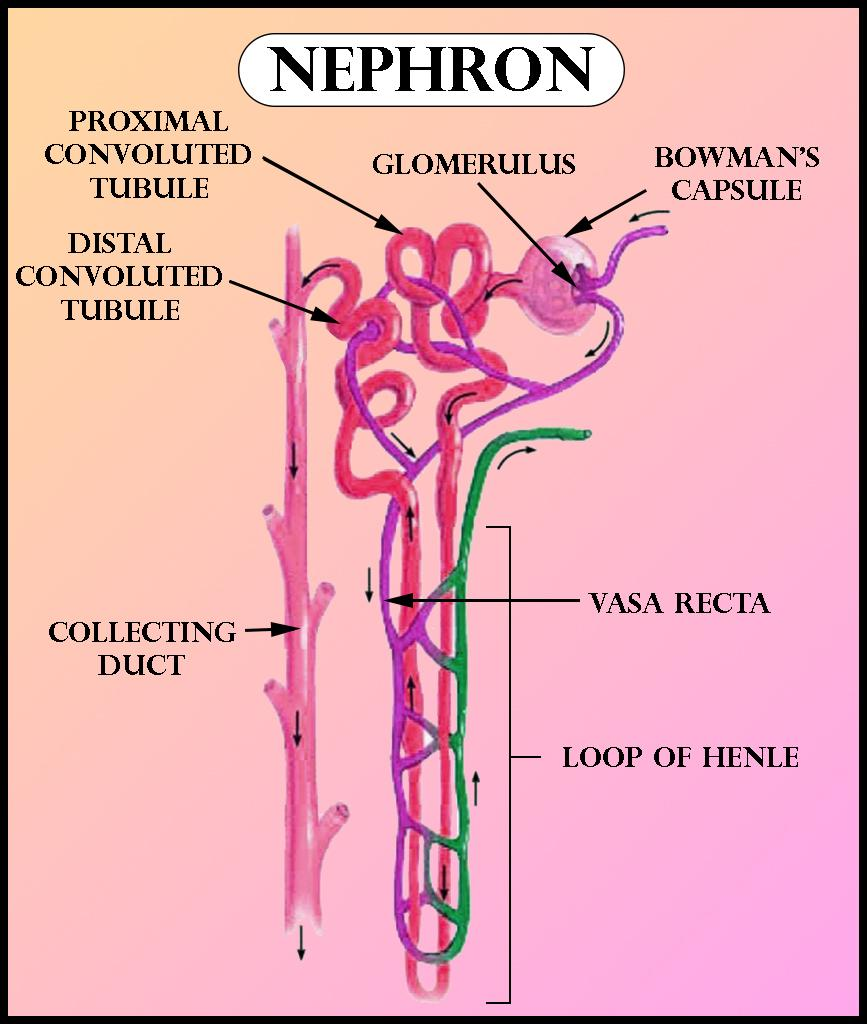
Region of nephron found in the renal medulla is
(a)Malpighian corpuscle
(b)Proximal convoluted tubule
(c)Distal convoluted tubule
(d)Henle's loop
(e)Glomerulus
Answer
564.6k+ views
Hint: Kidneys are made up of millions of basic functioning units called nephrons. This part got its name after Friedrich Gustav Jakob Henle, a German anatomist, who discovered it. Creating a concentration gradient inside the medulla in the kidney is the major function of this organ.
Complete answer:
The region of nephron found in the renal medulla is Henle’s loop. Henle's loop is a hairpin-shaped area of the tubule, with a descending limb and an ascending limb. The distal convoluted tubule, which is a highly coiled tube-like region is a continuation of the ascending limb.
Additional Information: -The glomerulus and the renal tubule are two major parts of the nephron. Efferent arterioles carry blood from the glomerulus. The glomerulus is enclosed by a double-layered cup-like structure known as Bowman's capsule renal.
-Malpighian body or renal corpuscle is a constitution of Glomerulus and Bowman's capsule. In many nephrons, the DCTs open into a straight tube called a collecting duct.
So, the correct answer is ‘Henle's loop’.

Note: -The Malpighian corpuscle, PCT, and DCT of the nephron are situated in the cortical region of the kidney, whereas the loop of Henle goes down into the medulla.
-The cortical nephrons are the nephrons in which the loop of Henle is small and stretches very little into the medulla. Juxtamedullary nephrons are the nephrons that have a long loop of Henle stretches and run deep into the medulla.
-Glomerulonephritis is an autoimmune disease where immune cells attack the nephrons, causing inflammation and damage, resulting in kidney failure and passage of blood and protein in the urine.
Complete answer:
The region of nephron found in the renal medulla is Henle’s loop. Henle's loop is a hairpin-shaped area of the tubule, with a descending limb and an ascending limb. The distal convoluted tubule, which is a highly coiled tube-like region is a continuation of the ascending limb.
Additional Information: -The glomerulus and the renal tubule are two major parts of the nephron. Efferent arterioles carry blood from the glomerulus. The glomerulus is enclosed by a double-layered cup-like structure known as Bowman's capsule renal.
-Malpighian body or renal corpuscle is a constitution of Glomerulus and Bowman's capsule. In many nephrons, the DCTs open into a straight tube called a collecting duct.
So, the correct answer is ‘Henle's loop’.

Note: -The Malpighian corpuscle, PCT, and DCT of the nephron are situated in the cortical region of the kidney, whereas the loop of Henle goes down into the medulla.
-The cortical nephrons are the nephrons in which the loop of Henle is small and stretches very little into the medulla. Juxtamedullary nephrons are the nephrons that have a long loop of Henle stretches and run deep into the medulla.
-Glomerulonephritis is an autoimmune disease where immune cells attack the nephrons, causing inflammation and damage, resulting in kidney failure and passage of blood and protein in the urine.
Recently Updated Pages
Master Class 12 Business Studies: Engaging Questions & Answers for Success

Master Class 12 Economics: Engaging Questions & Answers for Success

Master Class 12 English: Engaging Questions & Answers for Success

Master Class 12 Maths: Engaging Questions & Answers for Success

Master Class 12 Social Science: Engaging Questions & Answers for Success

Master Class 12 Chemistry: Engaging Questions & Answers for Success

Trending doubts
What is meant by exothermic and endothermic reactions class 11 chemistry CBSE

Which animal has three hearts class 11 biology CBSE

10 examples of friction in our daily life

One Metric ton is equal to kg A 10000 B 1000 C 100 class 11 physics CBSE

1 Quintal is equal to a 110 kg b 10 kg c 100kg d 1000 class 11 physics CBSE

Difference Between Prokaryotic Cells and Eukaryotic Cells




